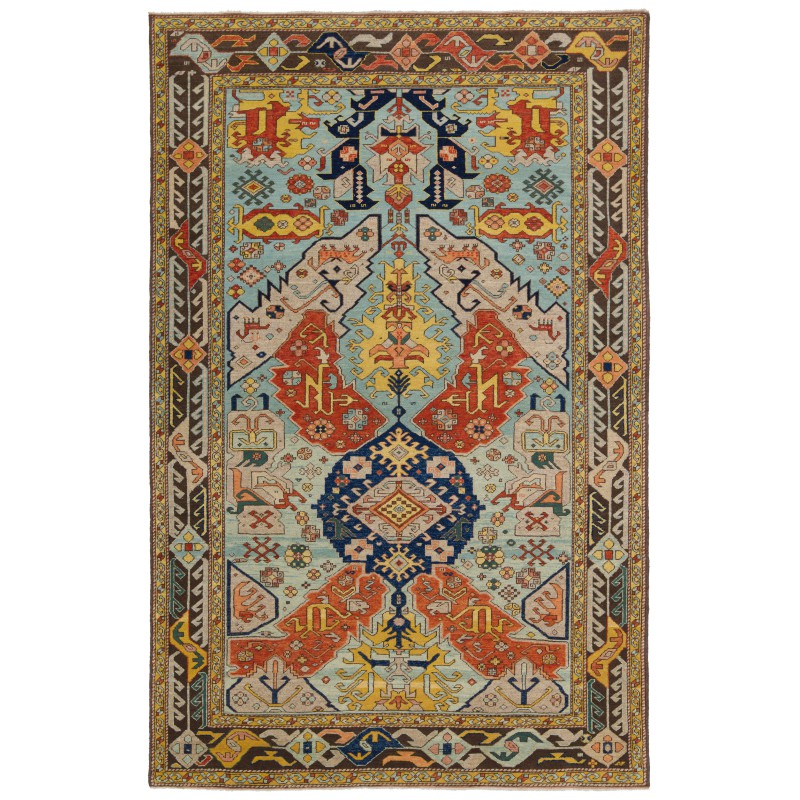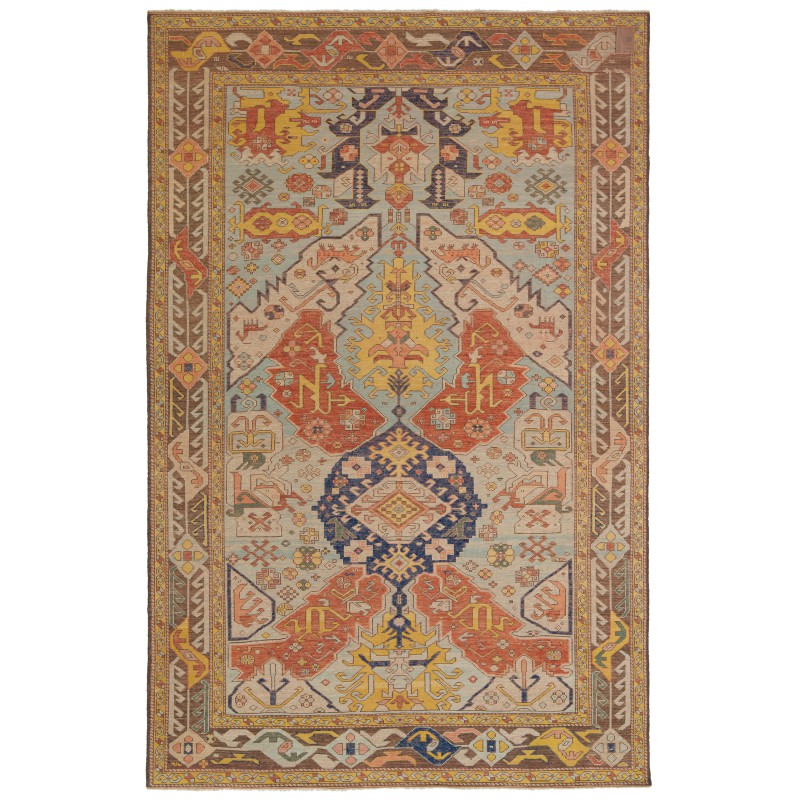



- Stock: 売り切れ
- Model: C50498
- サイズ: 263cm x 170cm
- SKU: ART498
ドラゴンとその描写に対する象徴主義には長い間魅了されてきました。『ドラゴン』絨毯のデザインは、尖ったギザギザの葉で作られた重なり合った異なる色の格子からなるフィールドパターンで構成されており、交差するひし形状を作り出しています。ひし形の中には交互にパルメットが配置され、対向するスタイライズされたドラゴン、鳥、または動物の図柄があります。最も古風な『ドラゴン』絨毯には、比較的自然に描かれた鳥や走る動物とともに単独または対峙する形で描かれたドラゴンのモチーフが含まれています。これらのタイプで最も古い例とされるグラフ絨毯は、もともとダマスカスのモスクで発見され、現在はイスラム美術館(ベルリン)に所蔵されており、Serare Yetkinの『Early Caucasian Carpets in Turkey』(1978年、ロンドン)のp.8、fig.118を参照してください。Yetkinによれば、『ドラゴン』絨毯には次の4つのタイプが存在します。「古風」、「四龍」、「龍と鳳凰」、さらに後者の発展形としての「二龍」スタイルです。現在の絨毯は「龍と鳳凰」グループに属し、ハンブルクの美術工芸博物館、エステルゴムのキリスト教博物館には2つの断片が含まれている他の例とともに、Kierコレクションの完全な絨毯、ワシントンD.C.のテキスタイル美術館の不完全な例、ルガーノのティッセン・ボルネミッサコレクションの「カシラー」ドラゴン絨毯、トカトのアリ・パシャモスクの絨毯、イスタンブールのヴァキフラール・ハリ美術館の他の例も含まれます(S. Yetkin, op. cit. pp.16-20)。カフカス地方の『ドラゴン』絨毯の初期の例では、織物の幅において反復回数が後の作品よりも多いとされています。また、現在の絨毯と同じく、チャールズ・ディアリング氏のコレクションから出品された『四龍』絨毯の例も偶然にも存在します(Sotheby's、ニューヨーク、2000年9月27日、ロット35)。
動物の戦闘グループは16世紀末から17世紀初頭に人気のある図柄で、ペルシャの絵画やブックカバー、そしてもちろんサファヴィ朝の壮大な絨毯にも現れました。これにより、カフカスの『ドラゴン』絨毯はモデル化された可能性があります(Duncan Haldane, Islamic Bookbindings in the Victoria and Albert Museum, London, 1983, no.106, pp.110-111, 参考)。17世紀の『Vase』絨毯にさかのぼることができるカフカス地方の古典的な絨毯の多くは、その格子状のデザイン自体が『Vase』絨毯の格子と関連しています(Ellis, op. cit, pp.12-13)。しかし、早い時期の『ドラゴン』絨毯では、ギザギザのパネルの彩色のために、格子のオーバーレイプレイが失われています。この絨毯のデザインは、当社のデザイナーによって選ばれた一連のボーダーや柔らかな色で解釈されています。
There has long been a fascination with the symbolism of the dragon and its depiction in carpet weavings. The design of ‘Dragon’ carpets consists of a field pattern composed of different colored overlaid lattices formed of pointed, serrated leaves creating intersecting lozenges, which alternately contain palmettes and are flanked by confronting stylized dragons, birds, or animal figures. The most archaic of the ‘Dragon’ carpets include dragon motifs with birds and running animals that are relatively naturalistically drawn, which stand either alone or in confronting pairs facing a tree. The Graf carpet, originally found in a Damascene mosque, now in the Islamiches Museum, Berlin, is considered to be the oldest example of this type, see Serare Yetkin, Early Caucasian Carpets in Turkey, Vol. II, London, 1978, p.8, fig.118. Yetkin defines four types of ‘Dragon’ carpet: ‘Archaic’, ‘Four-Dragon’, ‘Dragon-and-Phoenix’ and as a further combined development of the latter, the ‘Two-Dragon’ style, of which the present carpet falls into the ‘Dragon-and-Phoenix group along with other examples, some of which include two fragments, one in the Museum fur Kunst und Gerwerbe, Hamburg; another in the Christian Museum, Esztergom, Hungary, a complete carpet in the Kier collection; an incomplete example in the Textile Museum, Washington, D.C; the ‘Cassirer’ Dragon carpet in the Thyssen-Bornemisza collection, Lugano; the Ali Pasa Mosque carpet in Tokat, and a further example in the Vakiflar Hali Museum, Istanbul (S. Yetkin, op. cit. pp.16-20). It has been suggested that the earliest examples of the Caucasian ‘Dragon’ carpets have a greater number of repeats across the width of the weaving than in later pieces. An example of a ‘Four-Dragon’ carpet, also coincidentally from the collection of Charles Deering as the present carpet, was sold in Sotheby’s, New York, 27 September 2000, lot 35.
Animal combat groups were popular motifs in the late 16th and early 17th century, appearing in Persian paintings, book covers, and of course within the magnificent carpets of the Safavid court, from which it is probable that Caucasian ‘Dragon’ carpets were modeled (Duncan Haldane, Islamic Bookbindings in the Victoria and Albert Museum, London, 1983, no.106, pp.110-111, for example). Many of the classical Caucasian carpets of the 17th and early 18th centuries can be traced back to the ‘Vase’ carpets of the 17th century. The lattice used in these carpets itself relates to the lattice of ‘Vase’ carpets (Ellis, op. cit, pp.12-13), but already in the present early ‘Dragon’ carpet, the coloring of the serrated panels means that the overlay play of the lattice has been lost. The design of this rug is interpreted with a series of borders and soft colors chosen by our designers for this rug.全部で10色使っています。主な4色は以下です。
- Bistre Brown 411 (ザクロの皮 - 茜)
- Opal 533 (ヘナ - 藍)
- Khaki 413 (ホザキモクセイソウ)
- Barley Corn 103 (羊そのままの色)
上の番号は私たちのカラーコードです。()の中は、主な草木染めの材料です。
